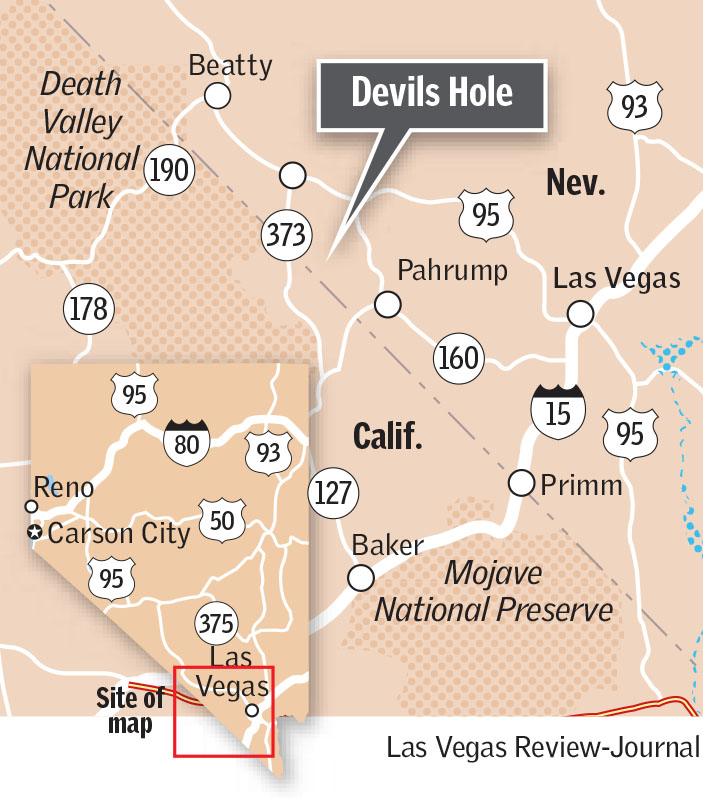Mexico quakes rattle Nevada’s endangered Devils Hole pupfish

Two deadly earthquakes in Mexico this month also left their mark on a water-filled cavern in Nevada that is home to one of the world’s most endangered fish.
In a mysterious geological phenomenon, shock waves from the quakes traveled more than 1,500 miles to churn the water inside the only known habitat of the Devils Hole pupfish, 80 miles west of Las Vegas.
The magnitude 8.1 quake that hit southern Mexico on Sept. 8 triggered an especially strong reaction, stirring waves tall enough to rip plants from the walls of Devils Hole 3 feet above the water’s surface.
“It rock and rolled,” said Kevin Wilson, a Death Valley aquatic ecologist for the National Park Service.
Tuesday’s devastating 7.1 quake near Mexico City produced smaller waves in the usually placid pool.
Well known, little understood
By now, the seismic phenomenon is well known to researchers, though still not fully understood.
“It has something to do with the magnitude and the depth” of the earthquakes, Wilson said.
The effect was caught on video in 2012 by a team of researchers who happened to be at Devils Hole when a 7.4 quake shook the mountains east of Acapulco, some 1,700 miles away. The footage shot by the surprised scientists can still be found on YouTube, where it has been viewed more than a million times.
Powerful quakes as far away as Japan and China have also caused the water to slosh at Devils Hole, but Nevada’s last big temblor in 2008 — a magnitude-6.0 that damaged buildings in Wells, a comparatively short 325 miles away — failed to produce so much as a ripple.
Waves generated by the two recent quakes in Mexico scoured away sediment and green algae from the shallow shelf that serves as the main feeding and spawning ground for the Devils Hole pupfish. Wilson described it as a natural “reset” for the habitat, though the timing isn’t great. The loss of algae at this time of year could result in a lean winter for the fish, he said.

On the edge of extinction
Wilson is part of a team dedicated to saving the species that includes the Park Service, the U.S. Fish and Wildlife Service and the Nevada Department of Wildlife.
They have their work cut out for them. The Devils Hole pupfish lives at the edge of extinction in an isolated habitat poorly suited for aquatic life. Geothermal heat warms the water in its flooded limestone cavern to about 93 degrees, and dissolved oxygen is scarce.
The species has been under federal protection since 1967.
Its population peaked at 544 in 1990, and bottomed out at 35 in the spring of 2013. The most recent count, conducted over the weekend, showed 115 adult fish, down from 144 last year at this time.
So far, Wilson said, the pupfish seem to be reacting to the earthquakes the way they have in the past: with an increase in mating and spawning behavior.
“It’s something that’s hard-wired into them,” he said. “‘OK, something’s happened. It’s time to make babies.’”
Contact Henry Brean at hbrean@reviewjournal.com or 702-383-0350. Follow @RefriedBrean on Twitter.
A soggy census
The Devils Hole pupfish lives in one of the smallest habitats of any vertebrate species on Earth, but counting them is no easy task.
The process takes several hours over multiple days and requires scuba gear, said Kevin Wilson, a Death Valley aquatic ecologist for the National Park Service.
The fish — all 115 of them — were counted last weekend by divers under the water and researchers working from catwalks at the surface of Devils Hole, 80 miles west of Las Vegas.
The scuba divers in two-person teams dove to a depth of about 100 feet to count the deepest fish.
Though it lies within the boundaries of Ash Meadows National Wildlife Refuge, Devils Hole is technically considered part of Death Valley National Park.
Wilson has described the flooded limestone cavern as “a window into the groundwater table.” It extends more than 430 feet underground, and the surface of the pool rises and falls slightly with the lunar cycle.
— Henry Brean












